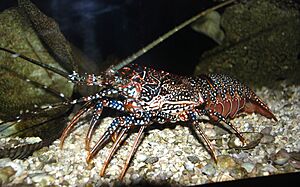Spotted spiny lobster facts for kids
Quick facts for kids Spotted spiny lobster |
|
|---|---|
 |
|
| Conservation status | |
| Scientific classification | |
| Genus: |
Panulirus
|
| Species: |
guttatus
|
| Synonyms | |
|
|
The spotted spiny lobster (scientific name: Panulirus guttatus) is a cool creature that lives in the warm, shallow waters of the western Atlantic Ocean and Caribbean Sea. It's also known as the Guinea chick lobster. Unlike many lobsters, it doesn't have big claws! Instead, it uses its long, spiny antennae to explore its rocky reef home.
Contents
What Does the Spotted Spiny Lobster Look Like?
This lobster has two eyes on stalks that can move around. It also has long, thick antennae covered in spines. Around its mouth, it has six small leg-like parts. It moves around using five pairs of walking legs. These legs do not have the large pincers you might see on other lobsters.
A spotted spiny lobster can grow up to about 20 centimeters (about 8 inches) long. However, most are usually around 15 centimeters (about 6 inches). Their bodies are a purplish-black color. They are covered with many bright, round white spots. Their main leg parts are dark with white spots. But the leg parts just before the last ones have dark stripes on a lighter background.
Where Do Spotted Spiny Lobsters Live?
The spotted spiny lobster lives in the tropical western Atlantic Ocean. You can find them in the Caribbean Sea and even in the Gulf of Mexico. Their home stretches from Bermuda and the Bahamas to southern Florida and the West Indies. They are also found near places like Curaçao and Suriname.
These lobsters prefer rocky reefs in shallow water. They live at depths of up to about 23 meters (about 75 feet). They often hide in small cracks or under big coral heads. During the day, they stay hidden in the coral reefs. At night, they come out from their safe spots to find food along the ocean floor.
Life and Habits of the Spotted Spiny Lobster
The spotted spiny lobster is a nocturnal animal. This means it is active mostly at night. It hunts for food using its sense of touch and by sensing chemicals in the water. It enjoys eating clams and snails. It also eats other small sea creatures like crabs and chitons.
How Spotted Spiny Lobsters Reproduce
In Bermuda, these lobsters usually breed from May to October. But in warmer areas, they can breed all year long. After mating, the female lobster carries her eggs. She keeps them safe under her tail on her belly.
When the eggs are ready to hatch, the female moves to the edge of the reef. She then releases the tiny eggs into the water. After releasing the eggs, she often sheds her old shell. The baby lobsters, called larvae, float in the water for a long time. They are very tiny at first. Later, they change into a stage called "pueruli" larvae. This is a step between floating babies and young lobsters that live on the seafloor. These young lobsters then settle on the outer parts of shallow reefs where the water moves a lot.
Why Are Spotted Spiny Lobsters Important?
People do not usually fish for this specific type of lobster on a large scale. However, they are sometimes caught by accident when people are trying to catch other sea animals. They can be caught by hand, with a spear, or in traps. Most of the time, they are sold and eaten locally.
What Is Their Conservation Status?
The spotted spiny lobster is a common species. It lives in a very wide area. Right now, there isn't a lot of commercial fishing for them. But this could change if the populations of other lobsters, like the Caribbean spiny lobster, start to decrease.
The International Union for Conservation of Nature (IUCN) is a group that checks on animals around the world. They have said that the spotted spiny lobster is a species of "least concern." This means they are not currently worried about it becoming endangered.


